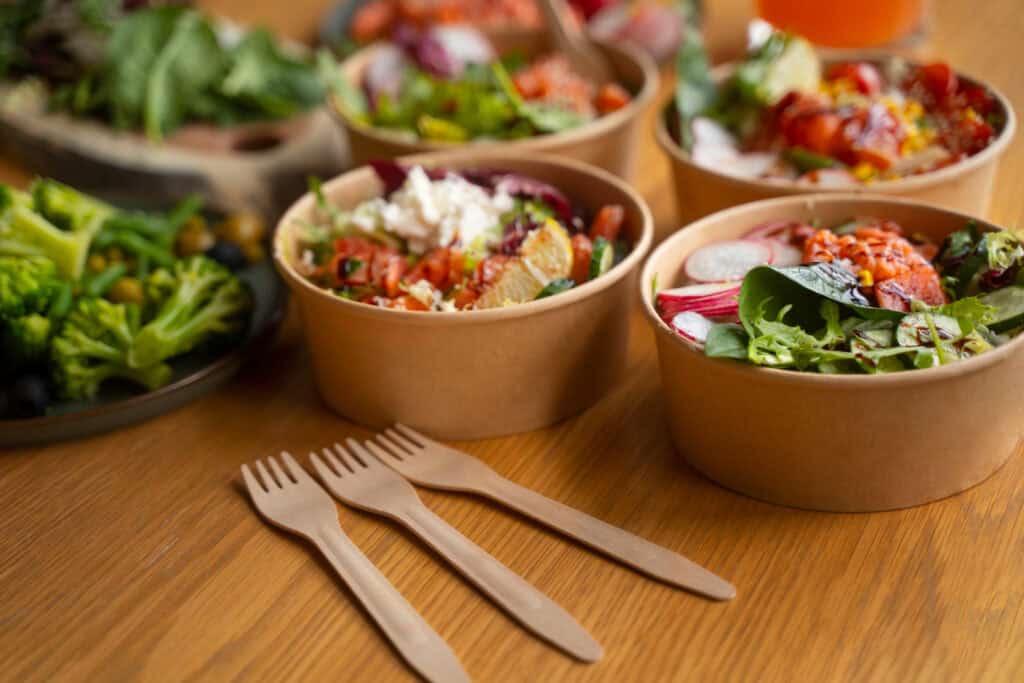
By Jermaine Thomas April 9, 2025
Catering businesses are under growing pressure to be more inclusive, flexible, and individualized in the constantly changing food service industry. The increasing demand for dietary flexibility is one important trend that is changing the industry. Customers now expect menus to represent a wider range of dietary preferences, whether motivated by personal lifestyle choices, ethical considerations, or health needs.
However, dietary flexibility is a wise business move as well as a way to satisfy customers. Changing your menu to accommodate a range of dietary requirements can boost customer loyalty, enhance brand recognition, and eventually boost profitability.
Understanding the Rise of Dietary Preferences
In the past, catering menus were often rigid, offering standard meat or vegetarian options with little room for variation. However, the landscape has shifted dramatically. Today’s customers are more health-conscious, informed, and vocal about what they want to eat; and what they won’t eat.
Dietary preferences now span a wide spectrum. From vegan and gluten-free to keto, paleo, dairy-free, and allergen-sensitive options, people expect food choices that align with their needs. This shift is fueled not only by health concerns and medical conditions but also by ethical beliefs, religious practices, and environmental consciousness.
For caterers, this means rethinking the one-size-fits-all approach. The ability to offer diverse and inclusive options is no longer just a nice touch; it’s become a basic expectation. Those who ignore these changes risk losing out to competitors who are more willing to accommodate individual needs.

Why Flexibility Matters to Clients
Food has a big impact on customers’ desire to feel seen, heard, and respected in today’s world. A catering service conveys the idea that a customer’s needs are unimportant when they disregard their dietary restrictions. On the other hand, it fosters trust and makes a good impression when a visitor with a nut allergy, for instance, sees that there are safe options available and that the labeling is clear.
A flexible menu plan demonstrates your business’s inclusivity and customer-focused approach. For weddings, business events, and other sizable gatherings where guest satisfaction is a top concern, this can be particularly crucial. A caterer who can confidently guarantee that everyone will have something to enjoy is much more likely to be hired by the organizers.
In short, being flexible with your menu isn’t just about food; it’s about experience. And great experiences lead to repeat business, word-of-mouth referrals, and better catering ROI over time.
The Financial Impact of Meeting Dietary Needs
At first glance, offering more menu options might seem costly. Additional ingredients, more prep time, and training staff to handle cross-contamination can increase overhead. However, the return on investment is often well worth it.
When caterers tailor their offerings to meet specific dietary preferences, they can expand their customer base. That couple looking for a completely vegan wedding? They’ll search for caterers who understand their needs. That company with a mix of gluten-intolerant and vegetarian employees? They’ll pay more for a caterer who can deliver inclusive meals. By offering these services, you position your business to win more contracts.
Moreover, offering dietary flexibility often leads to higher average spending per event. Clients are willing to pay a premium for personalized service, especially when dietary restrictions are involved. This directly boosts catering ROI and can offset the added costs of creating specialized dishes.
Additionally, reputation plays a role. Clients who feel catered to in a thoughtful, professional manner are more likely to leave positive reviews and recommend your services to others. That social proof can be a powerful business driver.
Flexible Menu Strategy: More Than Just Substitutions
Creating a flexible menu strategy isn’t just about swapping out ingredients; it’s about building a menu framework that can adapt to different needs without compromising quality, taste, or presentation.
Analyze your current menu first. Find staple foods that are simple to modify into vegan, gluten-free, or low-carb substitutes. For example, you could serve wraps with lettuce leaves in place of bread or substitute zucchini noodles for pasta dishes. It involves creating meals with personalization in mind.
Clear labeling is another component of a good flexible menu strategy. Be open and honest about the sugar content, allergens, and other specifics. This reduces inquiries and special requests during service, which not only reassures customers but also simplifies operations.
Training your employees is crucial from the standpoint of kitchen workflow. For those who suffer from allergies, cross-contamination and improper handling of ingredients can cause major problems. Putting money into appropriate training guarantees client satisfaction and safety.
Market Demand and the Value of Adaptability
Market research continually shows that dietary preferences are more than just a trend; they’re here to stay. A growing number of millennials and Gen Z consumers identify with plant-based or flexitarian diets, and food allergies are becoming increasingly common.
As a catering business, staying current with food trends and customer needs is essential to maintaining relevance. A flexible menu strategy allows you to evolve alongside your customers, ensuring your offerings are always aligned with market demands.
For example, a few years ago, “gluten-free” options were niche. Today, they’re expected. The same shift is happening with plant-based proteins and sustainable food sourcing. By staying ahead of these changes, you build a reputation as an innovative and responsible brand.
In business terms, adaptability equals resilience. The more flexible your menu, the more adaptable your business model becomes in response to shifts in customer behavior or food supply challenges. This not only enhances your catering ROI but also builds a stronger foundation for long-term growth.
Success Through Flexibility
By using flexible menus, catering businesses all over the world have experienced quantifiable success. After introducing a menu that exclusively featured allergen-safe options, a well-known corporate catering service in New York reported a 40% increase in reservations. Employees felt more at ease eating food at events, and clients valued the transparency.
In a different instance, a plant-based catering boutique in California expanded from a small business to a full-fledged enterprise after becoming the preferred choice for vegan and health-conscious events. Their readiness to adapt to customer demands and experiment with ingredients contributed to building a devoted customer base.
These stories illustrate how dietary preferences, when taken seriously, can be turned into opportunities. Businesses that listen and adapt are rewarded not only with customer loyalty but with better bottom-line results.
Challenges of Implementing Dietary Flexibility
Of course, integrating a flexible menu strategy isn’t without challenges. There are logistical concerns; how to prep and store various ingredients, prevent cross-contamination, and maintain flavor and consistency across versions of the same dish.
It also requires an investment of time and effort in research, sourcing alternative ingredients, and educating kitchen staff. If poorly executed, it can backfire; bland food, unsafe practices, or chaotic service can damage your reputation.
But these challenges are not insurmountable. Start small. Introduce a few flexible options and monitor customer response. Use feedback to refine your offerings. As confidence builds, expand your range. The key is to approach it as a long-term strategy rather than a quick fix.
Enhancing Brand Image Through Inclusive Menus
Dietary inclusivity is a part of a broader cultural movement toward equality, empathy, and personalization rather than merely a business fad. Providing a range of choices makes it obvious that your company values and respects each and every one of its clients.
That message can significantly affect your brand’s image in the socially conscious world of today. Clients want to associate with businesses that share their values, and dietary flexibility fits in with values like inclusivity, sustainability, and health.
Prioritizing a flexible menu strategy will help you create a brand that people are proud to support in addition to increasing catering ROI. Additionally, word-of-mouth promotion and enduring loyalty can be fueled by that emotional bond.
Tools and Tips for Creating a Flexible Menu
Successfully developing a flexible menu starts with understanding your customer base. Talk to past clients, survey your audience, and study industry trends to find out which dietary preferences are most common.
Once you have that data, identify versatile ingredients and dishes that can accommodate modifications. Focus on naturally inclusive foods; like rice bowls, grain salads, soups, or curries; that can be easily adapted for different needs.
Labeling is another vital step. Use clear icons or language to indicate gluten-free, dairy-free, vegan, or nut-free options. This simplifies decision-making for clients and builds trust.
Finally, create a menu structure that highlights flexibility as a feature, not an afterthought. List core dishes followed by optional modifications. This makes it easy for clients to customize orders without feeling like they’re making special requests.

Measuring Success: How Flexibility Improves Catering ROI
To truly make the business case for dietary flexibility, you need to measure its impact on your bottom line. Keep track of metrics like:
- Increase in event bookings due to menu adaptability
- Client satisfaction and retention rates
- Upcharges or premium pricing for customizations
- Time saved through efficient service planning
- Positive reviews and social media mentions
When you correlate these improvements with your revenue growth, the value of a flexible menu strategy becomes clear. Not only are you meeting customer expectations; you’re building a more profitable, sustainable business.
Conclusion
In a competitive catering industry, continuing with the same old methods won’t suffice. Clients are changing, and their dietary requirements are changing as well. Accommodating dietary preferences through careful and well-planned menu choices is not only excellent service; it’s smart business.
An adaptable menu approach provides you with the means to attract more customers, establish a solid reputation, and boost your catering ROI. It’s not about featuring 100 unique dishes; it’s about ensuring that your main selections are versatile, inclusive, and suited to the diverse dietary needs of today.
The next time you create a catering proposal or plan a menu, think about how flexibility might enhance not only the dining experience but also your business itself. When your food adapts to your customers, your enterprise becomes truly memorable.